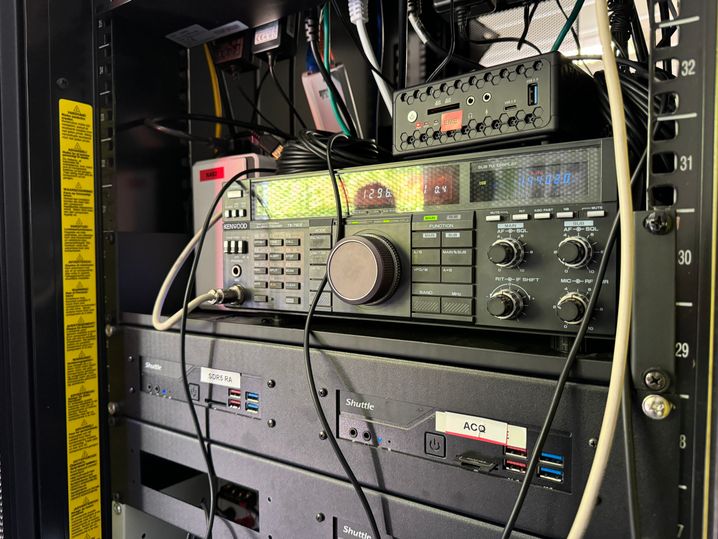What is this big antenna? Facing the Cité des sciences et de l’industrie de La Villette (Paris, 19th), an enormous parabola has resumed its movements facing the sky. Asleep for twenty-nine years, the radio telescope Parisian (a rather unique machine according to experts!) had never revealed its secrets. It is now done. 20 minutes was able to witness its (re)commissioning… when it could well have ended up in the scrapyard.
What is a radio telescope?
Our story begins in 1977. President Valéry Giscard d’Estaing asked physicist Maurice Lévy to submit a report to him on the relevance for France of having a large museum of science and industry. Among the thousand facets of the Cité des sciences et de l’industrie de la Villette (Paris, 19th) which will be inaugurated in 1986 by François Mitterrand is a radio telescope.
Compared to classic telescopes which allow us to observe space and distinguish shapes and colors, a radio telescope does not observe the universe in visible light, but with radio light, invisible to the eye. Thus, radio waves detect neutral hydrogen (very present in the universe) and electrified and magnetized objects, such as stars, planets, pulsars.
And advantage: unlike telescopes, a radio telescope can be used day and night, without the sky being clear. An opportunity for the Cité des sciences et de l’industrie to offer observational science to the general public…
Installed in 1986, never used
But, back to our story. It is now 1986. Developed by Nançay Observatory, in Sologne (a world reference), our radio telescope plants its ten-meter diameter antenna to the left of the Cité, a few steps from the Géode. Paradoxically, it is never implemented.
Worse: during work on the park in 1989, an excavator cut the cable that connects it to the main building! This real umbilical cord which would have allowed the public to make observations and infuse science, will never be restored… the repairs being estimated at 37,000 euros. Yes, the story can be ugly, too!
But also beautiful. It was not until 2007 that Doctor Bernard Pidoux, an enlightened radio amateur, approached La Villette with an association of enthusiasts. “They trusted us, we repaired the radio telescope, but it still took us sixteen years – including five blank years – to put it back into operation,” tells 20 minutes Bernard Pidoux. The motor that allowed the antenna to rotate was broken, rust had started to eat away at it, and it was only with the help of thehackerspace from Nanterre Electrolab that the radio telescope could be rehabilitated. “It’s doing as well as what was expected in 1986! », welcomes Bernard Pidoux. Even better !
Observe the Crab Nebula
Thanks to the volunteers of Parabolic Dimension, the association that Bernard Pidoux now chairs and of which Hubert Reeves was honorary president, a transmitter completed the installation. The radio telescope is therefore no longer content with listening to the song of the stars, but can also play its own melodies.
Thus, the large antenna which receives the waves from radio sources (or radiosources) which are the super Nova, the Sun and the Crab Nebula, it now emits. To do this, the association’s volunteers use the Moon as a passive reflector to contact other radio amateurs around the planet.

And, more fun, for demonstrations for the public. Like sending a signal to the Earth’s satellite and only waiting 2.6 seconds to receive the echo! “It allows you to understand complicated concepts and to delight the public,” enthuses Rémi Hutin, member of Dimension Parabole.
Eternally enthusiastic, this former engineer has no equal when it comes to explaining to the public what the La Villette radio telescope can be used for. And don’t be fooled by the (assumed!) jumble of cables tangled in the container at the base of the antenna. Transformed into a reception room and control tower, the premises are perfectly organized…

2024: our story ends well. Now connected to the radio beam of the Cité des sciences et de l’industrie, but also via Wifi (therefore controllable remotely), the radio telescope no longer has to fear that an excavator will come to silence it by accidentally cutting a cable buried in the basement. Nor that we forget it.
Its information is accessible from the Cité des sciences et de l’industrie, but also from the Palais de la Découverte. At the base of the antenna, the general public is especially welcome on Saturday and Sunday too.

On June 10, Blanca Li, president of the Public Establishment of the Park and the Grande Halle de la Villette, and Bruno Maquart, the President ofUniversescience (the public establishment of the Palais de la Découverte and the Cité des Sciences et de l’Industrie) attended the presentation of the radio telescope at Parc de la Villette. 38 years after its installation, an inauguration which barely veiled its name.

